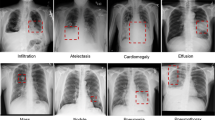Abstract
We have developed several morphological image filters that can be useful for computer-aided medical image diagnosis. Several computer-aided diagnosis (CAD) systems for lung cancer and breast cancer have been developed to assist the radiologist’s diagnostic work. The CAD systems for lung cancer can automatically detect pathological changes (pulmonary nodules) with a high true-positive rate (TP) even under low false-positive rate (FP) conditions. On the other hand, the conventional CAD systems for breast cancer can automatically detect some pathological changes (calcifications and masses), but the TP for other changes, such as architectural distortion, is still very low. Motivated by the radiologist’s cognitive processes to increase TP for breast cancer, we propose new methods to extract novel morphological features from X-ray mammography. Simulation results demonstrate the effectiveness of the morphological methods for detecting tumor shadows.
Similar content being viewed by others
Explore related subjects
Discover the latest articles, news and stories from top researchers in related subjects.References
Iinuma T, Tateno Y, Matsumoto T, et al (1992) Preliminary specification of X-ray CT for lung cancer screening (LSCT) and its evaluation on risk-cost-effectiveness (in Japanese). Nippon Acta Radiol 52:182–190
International Early Lung Cancer Action Program (I-ELCAP) (2006) Survival of patients with stage I lung cancer detected on CT screening. N Engl J Med 355(17):1763–1771
Okumura T, Miwa T, Kako J, et al (1998) Variable-N-quoit filter applied for automatic detection of lung cancer by X-ray CT (in Japanese). Proceedings of Computer-Assisted Radiology, pp 242–247
Lee Y, Hara T, Fujita H, et al (1997) Nodule detection on chest helical CT scans by using a genetic algorithm. Proceedings of the IASTED International Conference on Intelligent Information Systems, pp 67–70
Suzuki K, Armato SG, Le F, et al (2003) Massive training artificial neural network (MTANN) for reduction of false-positives in computerized detection of lung nodules in low-dose computed tomography. Med Phys 30(7):1602–1617
Nakamura Y, Fukano G, Takizawa H, et al (2005) Recognition of X-ray CT image using subspace method considering translation and rotation of pulmonary nodules (in Japanese). Technical Report of IEICE, vol 104, No. 580, MI2004-102, pp 119–124
Homma N, Takei K, Ishibashi T (2008) Combinatorial effect of various extraction features on computer-aided detection of pulmonary nodules in X-ray CT images. WSEAS Trans Inf Sci Appl 5(7):1127–1136
Endo T (2000) Trends of breast cancer medical examination by using mammography in Japanese). Health Culture, October
Ito A (2008) Mammography. In: Yanagama I, et al (ed) Master text book for radiological technologists, vol 1 (in Japanese)
Fujita K, Hara T, Matsubara Y (2006) Computer-aided diagnosis (CAD) in the field of breast-cancer image diagnosis (in Japanese). J Med Imag Inform 23(2)19-26
Takeo H, Shimura K, Imamura T, et al (2004) Development of system for detecting abnormal shadows in CR mammograms and its performance evaluation (in Japanese). Med Imag Technol 22(4)201-214
Mammography Guideline, 2nd edn (in Japanese) (2007) Japan Radiological Society and Japanese Society of Radiological Technology (ed) Gawks-Shorn
Author information
Authors and Affiliations
Corresponding author
Additional information
This work was presented in part at the 14th International Symposium on Artificial Life and Robotics, Oita, Japan, February 5–7, 2009
About this article
Cite this article
Homma, N., Kawai, Y., Shimoyama, S. et al. A study on the effect of morphological filters on computer-aided medical image diagnosis. Artif Life Robotics 14, 191–194 (2009). https://doi.org/10.1007/s10015-009-0651-8
Received:
Accepted:
Published:
Issue Date:
DOI: https://doi.org/10.1007/s10015-009-0651-8




